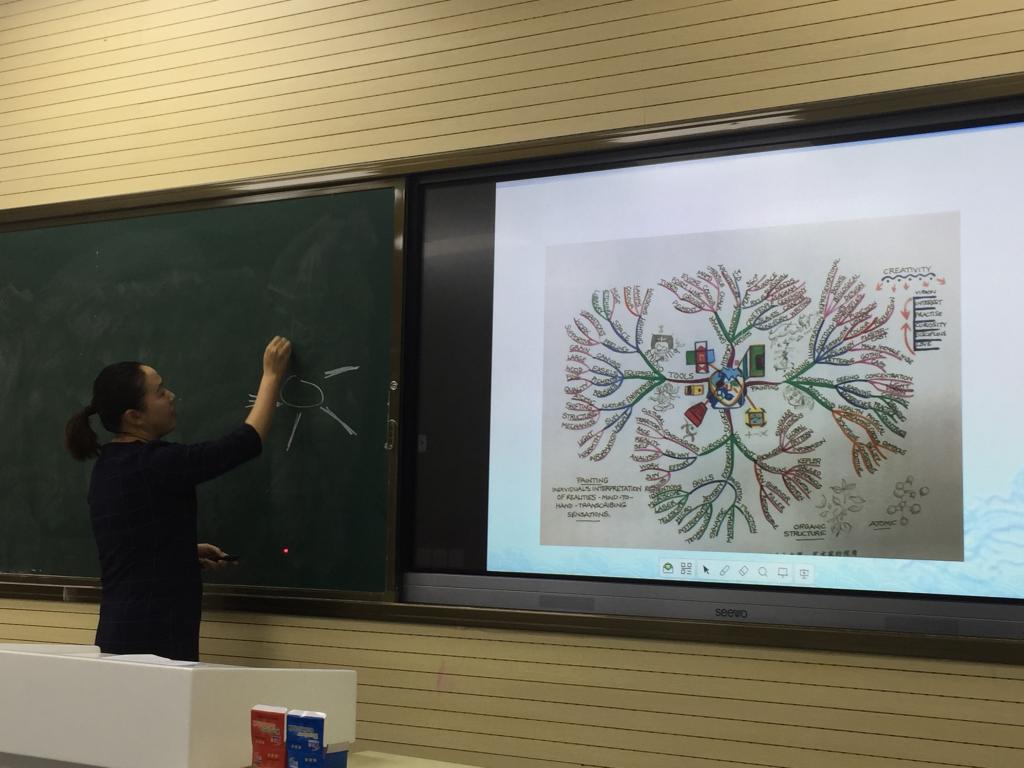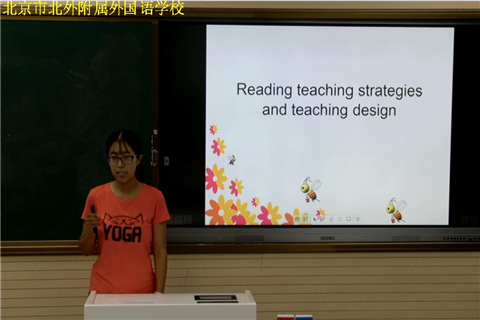說教學(xué)策略,,秀英語素養(yǎng) ——記初中英語教研組開展教學(xué)策略&學(xué)科素養(yǎng)展示交流系列活動之二
發(fā)布日期:2018-09-28 信息來源:
9月26日下午,,我校初中英語教研組在錄課室進行了以“說教學(xué)策略,秀英語素養(yǎng)”為主題的教學(xué)策略及學(xué)科素養(yǎng)展示交流系列活動第二期,。8名教師分別從課堂教學(xué)的不同角度分享了他們的教學(xué)經(jīng)驗和思考,。
張碩老師圍繞合作學(xué)習(xí)策略,就其定義,,基本要素,,課堂教學(xué)策略以及合作學(xué)習(xí)的優(yōu)勢展開分享,結(jié)合閱讀課,,寫作課,,語法課進行運用上的探討,從而引導(dǎo)不同學(xué)習(xí)程度的學(xué)生都能積極參與課堂,,實現(xiàn)成功,。
Cooperative Learning refers to a set of instructional methods in which students work in small, mixed-ability learning teams. The students in each team are responsible not only for learning the material being taught, but also for helping their teammates learn. Think-share-pair, Jigsaw and Three-minute review are three effective ways that can be applied in our practical class.

Graphic organizers在英語課堂上的應(yīng)用越來越廣泛,其中思維導(dǎo)圖在寫作課上能夠幫助,。學(xué)生針對特定話題,,對零散的想法加以區(qū)分,決定寫作素材并確定文章結(jié)構(gòu),,教師也得以了解學(xué)生的思維過程,。而在閱讀課后,學(xué)生通過繪制思維導(dǎo)圖,,加深對文章的結(jié)構(gòu)和細(xì)節(jié)的理解,,并借助思維導(dǎo)圖進行復(fù)述,教師則能通過這一過程檢查學(xué)生對文本的理解程度,。思維導(dǎo)圖課題組的陳瑩,、王珊和谷麗華老師分別從理論和實踐的不同方面對思維導(dǎo)圖在英語教學(xué)中的應(yīng)用做了闡述。
Visual thinking and learning utilize graphical ways of working with ideas and presenting information. Mind maps provide teachers with insight into our students’ thought process regarding a specific topic. By asking students to create mind maps demonstrating their comprehension of the material being taught, teachers are able to understand what a student’s prior knowledge was and how well the student understands it. This is a very effective way of evaluating students’ understanding. So they are widely used in English writing and reading lessons.



彭萌老師從如何提高閱讀教學(xué)著手,,提出閱讀活動的有效設(shè)計應(yīng)該考慮三個方面內(nèi)容:教材內(nèi)容的分析,、閱讀課時的定位、不同階段的活動設(shè)計,。讀前的活動設(shè)計應(yīng)該遵循激發(fā)學(xué)生閱讀興趣與動機,、引出話題、激活并提供背景知識,、掃除閱讀語言障礙的原則,;讀中應(yīng)遵循的原則是:通過閱讀活動幫助學(xué)生理解文章內(nèi)容、培養(yǎng)學(xué)生閱讀技能和策略的原則,;讀后活動設(shè)計原則應(yīng)遵循進行思維活動加深對文章理解,、鼓勵學(xué)生將所學(xué)與自己的經(jīng)歷、知識,、興趣觀點相練習(xí)創(chuàng)設(shè)機會讓學(xué)生進行表達的原則,。
Reading is very important in English learning. Reading teaching activities include three aspects: pre-reading activities, while-reading activities and post-reading activities. To motivate students’ interest, lead in the topic, activate and supply background information as well as removing language obstacles for further reading, pre-reading activities is a must. While-reading activities should help students understand the text, cultivate Ss’ reading skills and strategies. Post-reading activities should deepen understanding of the texts and encourage students to make the texts related to experiences, knowledge, interests and perspectives of their own; create chances for them to speak and express by using the reading texts.

詞匯永遠(yuǎn)是英語學(xué)習(xí)者最大的障礙。魏瑋琳老師結(jié)合自己對學(xué)生的觀察,,與學(xué)生面對面的交流,,從學(xué)生的聽寫,檢測以及作業(yè)反饋中總結(jié)了學(xué)生在詞匯學(xué)習(xí)上的主要問題,,并針對這些問題提出了解決辦法,,首先,在單詞記憶的方法上給與指導(dǎo),,循序漸進的教學(xué)生音標(biāo),,自然拼讀,以及常見的詞綴,。其次,,不斷地重復(fù)。最后也是最重要的,,我們應(yīng)該從單詞的形式,,意義以及用法全面的記憶單詞。
As Brithsh Linguist D.A.Wilkins once said, "without grammar, very little can be conveyed; without vocabulary, nothing can be conveyed."Vocabulary is one of the biggest obstacles on our way to learn English. According to observation, talking with the students face to face, feedback from the exercise, we found that mechanical memory, being easy to forget, lack of confidence, lack of initiative are the most common problems. Aiming to solve these problems, there are three solutions put forward-method, repetition, and word web.

李玉英老師根據(jù)本組的教研課題《英語聽說教學(xué)策略研究》下的課例,,闡述了如何將支架式教學(xué)理論應(yīng)用于初中英語聽說教學(xué),。根據(jù)該理論,將聽說教學(xué)的課堂設(shè)計分為搭腳手架,,進入情境,,獨立探索,協(xié)作學(xué)習(xí),,效果評價五個部分,。通過該方法,,學(xué)生不僅有效地吸收了知識,而且還能結(jié)合自己的實際情況對聽力內(nèi)容背后的深意進行思考,,并運用于實踐,。
Ms. Li shared the research result of their team’s project “Research on English Listening and Speaking Teaching Strategy”. In her presentation, she introduced how to apply the scaffolding teaching theory to a listening and speaking class so that students can really digest what they hear as well as ponder the deep meaning of the listening material with the combination of their own situation.

眾所周知,語言最基本的功能就是交流,,語言交際能力是在不斷的運用過程中提高的,,為了提高學(xué)生的語言能力,我們應(yīng)該在平時給他們更多練習(xí)口語表達的機會,。我們都把每天的課前三分鐘當(dāng)做一個給英語課熱身的好機會,,但是如何合理有效地使用這三分鐘呢?許秀老師跟大家分享了她的一些想法,。首先,,她介紹了課前三分鐘演講的好處,然后跟大家分享了她的日常做法,,如:學(xué)生準(zhǔn)備工作,,演講要求,教師評估,,同伴點評和改進方法等,。最后,她播放了兩段學(xué)生的演講視頻,,同時她也提到了學(xué)生們的熱情和努力一直激勵她做得更好,,她希望英語課前三分鐘演講會做的更有創(chuàng)意,有效,,有意義,。
As we know,the basic function of language is communicating. In order to improve our students’ language competence, we have to provide them with more chances for oral practice .We all regard the daily report as a good way to warm up our English class,but how to use the 3 minutes wisely? Xuxiu shared some of her ideas.First, she introduced the benefits of doing daily report,and shared her normal practice, including making preparions, requirements, evaluation, peer assessments, and improvement. She also showed us two video clips about her students’ performances. At the end of the speech , she mentionedthat students’ enthusiasm and hard work encouraged her to think about making it more creative, effective and meaningful.

隨著說課教師的增加,老師們演講的內(nèi)容也越來越豐富和有針對性,。本次活動相比上一期出現(xiàn)了圍繞同一話題的不同層面的分析,,也展現(xiàn)出更多理論與實踐相結(jié)合的經(jīng)驗與思考,參與活動的教師都從中獲益匪淺,。本次活動依然進行了全程錄像,,資料組內(nèi)共享,作為后續(xù)學(xué)習(xí)提高的資源,。
(供稿:初中英語教研組 編輯:何穎)




